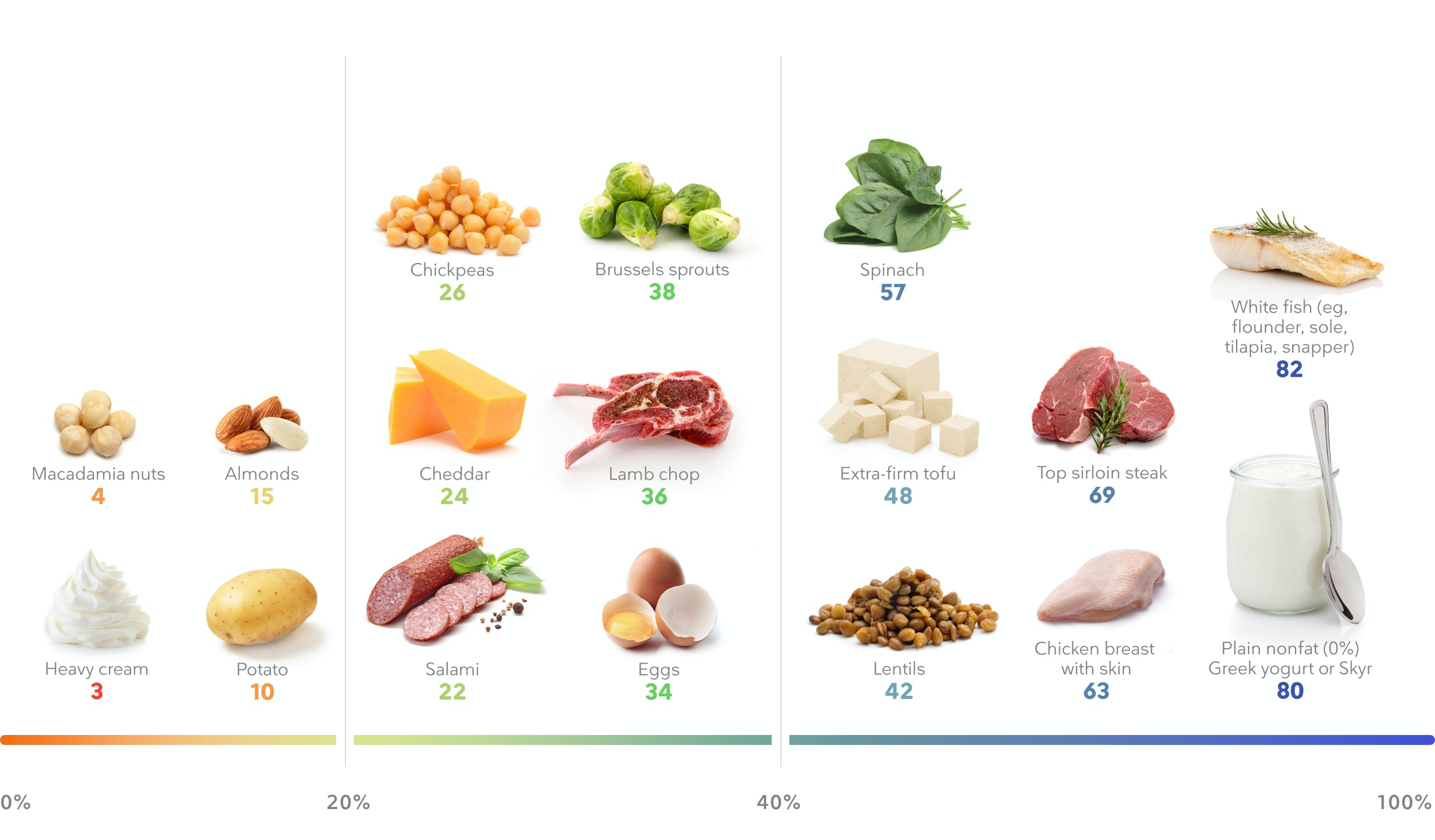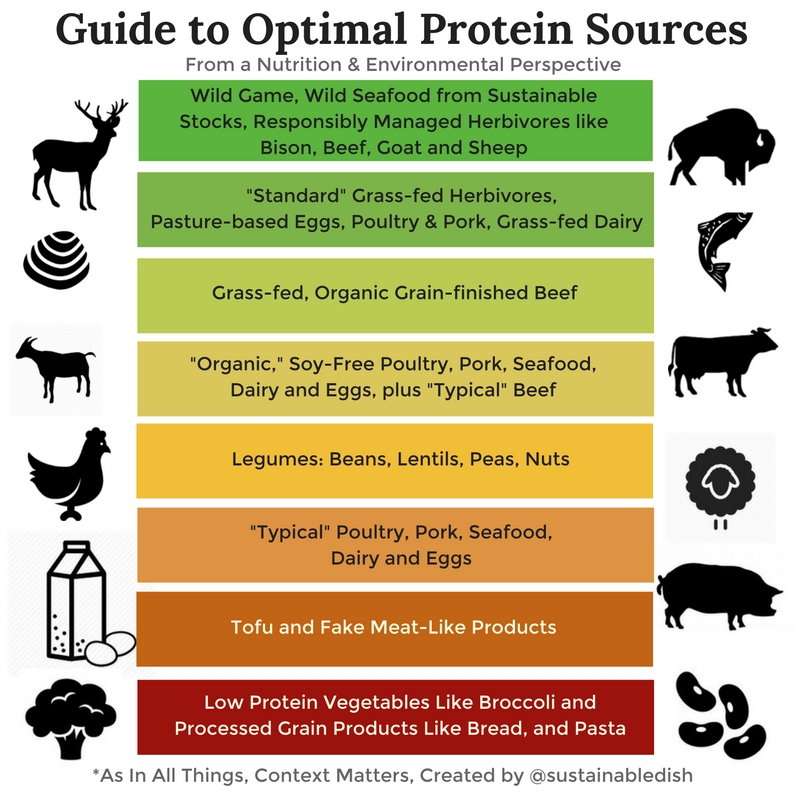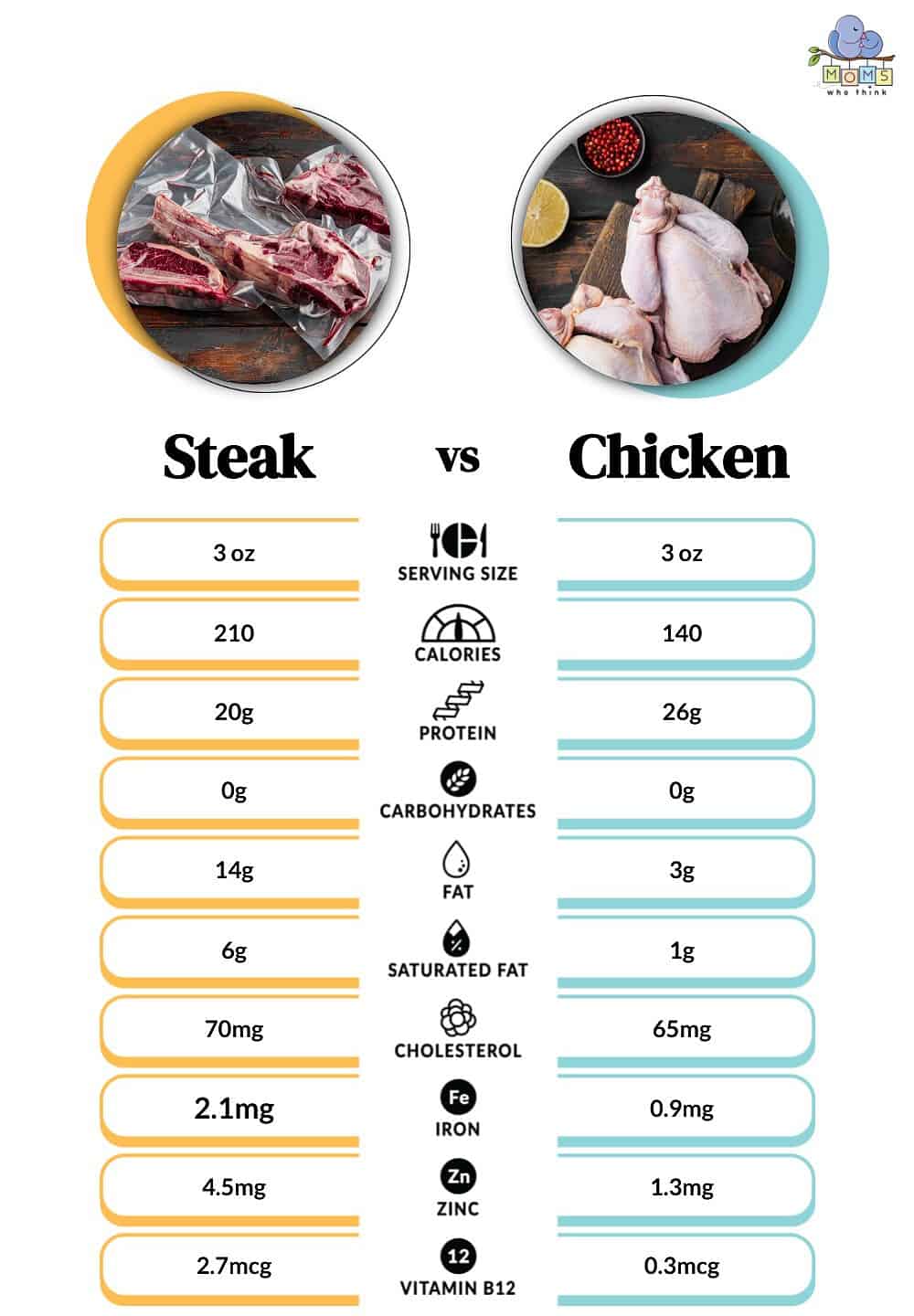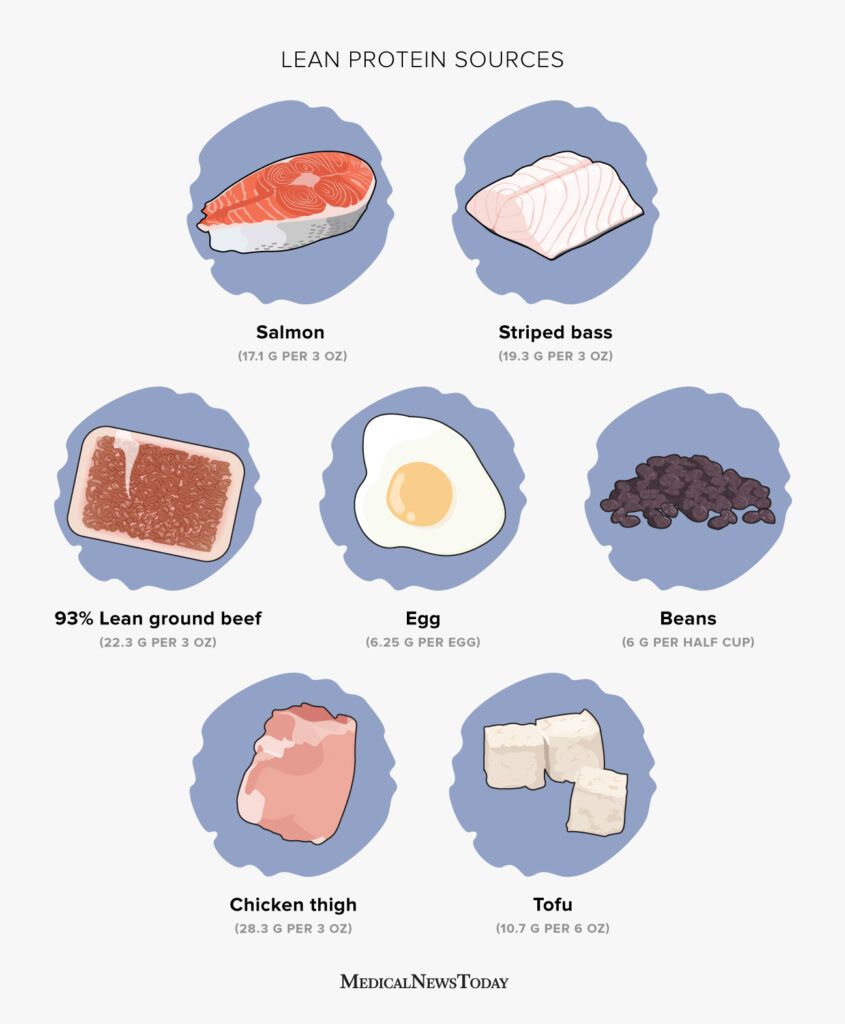Nutritional Comparison

When it comes to comparing the nutritional value of chicken and lamb, there are a few key factors to consider. Both meats are excellent sources of protein, which is essential for building and repairing tissues. However, lamb tends to be higher in fat, with 9 grams of fat in a 100-gram serving of sirloin, compared to just 3.6 grams in chicken breast. Lamb also contains 3 grams of saturated fat. It’s important to keep these differences in mind when deciding which protein source best fits your dietary needs.
Chicken Vs Lamb: Protein Content And Quality
Chicken and lamb are both excellent sources of protein, essential for building and repairing tissues. Chicken has a slightly higher protein content, with 31 grams of protein in a 100-gram serving of chicken breast, compared to 28 grams in lamb sirloin. Protein quality is also important, and both meats provide all the essential amino acids needed by the body. Therefore, whether you choose chicken or lamb, you can be confident that you are getting a high-quality protein source to support your overall health and wellness. (References: , )
Chicken Vs Lamb: Vitamins And Minerals
Both chicken and lamb provide important vitamins and minerals, although their levels may vary slightly. Chicken is a good source of B vitamins, including niacin, vitamin B6, and vitamin B12, which help support energy production and nerve function. It also contains essential minerals like zinc, phosphorus, and selenium. On the other hand, lamb is rich in iron, which is crucial for red blood cell production and oxygen transport. It also contains vitamins such as vitamin B12 and vitamin D. Including both chicken and lamb in your diet can help ensure a well-rounded intake of essential vitamins and minerals.
Health Benefits

Chicken offers various health benefits, making it a popular choice for weight management and muscle growth. With its high protein content, chicken helps in building and repairing muscles, which is essential for individuals involved in regular exercise or strength training. It is also a lean meat option, low in fat and calories, making it suitable for weight management. On the other hand, lamb provides benefits for heart health due to its high content of omega-3 fatty acids. Additionally, lamb is an excellent source of iron, aiding in red blood cell production and preventing anemia.
Chicken: Benefits For Weight Management And Muscle Growth
Chicken offers various health benefits, making it a popular choice for weight management and muscle growth. With its high protein content, chicken helps in building and repairing muscles, which is essential for individuals involved in regular exercise or strength training. It is also a lean meat option, low in fat and calories, making it suitable for weight management. Chicken provides essential amino acids that support muscle synthesis and can help promote a faster metabolism. Including chicken in a balanced diet can contribute to maintaining a healthy weight and achieving fitness goals.
Lamb: Benefits For Heart Health And Iron Intake
Lamb offers several benefits for heart health and iron intake. It is a good source of heme iron, which is more easily absorbed by the body compared to non-heme iron found in plant-based foods. Adequate iron intake is important for preventing anemia and maintaining healthy blood cells. Additionally, lamb contains omega-3 fatty acids, which have been linked to a reduced risk of heart disease. These fatty acids help reduce inflammation and promote heart health by lowering triglyceride levels and improving blood vessel function. Including lamb in a balanced diet can contribute to a healthy heart and sufficient iron levels.
Culinary Uses

Both chicken and lamb offer a wide range of culinary uses, providing versatility in various dishes. Chicken is known for its ability to adapt to different flavors and cooking techniques, making it a popular choice for grilled, baked, or sautéed dishes. It can be used in salads, stir-fries, soups, and even as a filling for sandwiches and tacos. On the other hand, lamb is commonly used in slow-cooked dishes, such as stews and roasts, where its rich flavor shines. It is also a key ingredient in dishes like kebabs, curries, and Mediterranean-inspired dishes. Whether you prefer the subtle taste of chicken or the robust flavors of lamb, both meats offer a wide range of culinary possibilities.
Cooking Techniques For Chicken And Lamb
When it comes to cooking chicken, it can be prepared using various techniques to achieve different flavors and textures. Some common cooking methods for chicken include grilling, baking, sautéing, and frying. Grilled chicken offers a smoky flavor and crispy skin, while baking provides a tender and juicy result. Sautéing chicken in a pan with some oil creates a delicious golden crust. On the other hand, lamb is often slow-cooked to enhance its rich, tender flavor. Braising, roasting, and stewing are popular techniques for lamb, allowing it to become savory, succulent, and melt-in-your-mouth.
Flavor Profiles And Versatility In Dishes
Both chicken and lamb have distinct flavor profiles that lend themselves well to a variety of dishes. Chicken is known for its mild and versatile taste, making it suitable for a wide range of culinary creations. It can be seasoned and flavored in various ways to suit different cuisines, from tangy teriyaki to savory herb-infused dishes. On the other hand, lamb has a robust and distinct flavor that pairs well with bold spices and herbs. It is commonly used in dishes like curries, stews, and roasted preparations to enhance its unique taste. Whether you prefer the subtle or bold flavors, both chicken and lamb offer endless possibilities in the kitchen.
Environmental Impact

When considering the environmental impact of protein sources, it is important to evaluate factors such as greenhouse gas emissions and sustainability. In this regard, chicken proves to be a more sustainable option compared to lamb. Chicken production has a significantly lower greenhouse gas footprint, emitting nearly nine times less CO2e per 100g of protein than beef. Additionally, practices such as free-range and organic farming contribute to reducing environmental impact. By choosing chicken over lamb, individuals can make a positive contribution to environmental sustainability without compromising on taste and nutrition .
Sustainability Of Chicken Farming
Chicken farming is a more sustainable option compared to lamb production. Chicken farms require less land, water, and feed, leading to a smaller ecological footprint. In addition, chicken farming has the potential for vertical integration, where different aspects of production are integrated to maximize efficiency and reduce waste. Practices such as free-range and organic farming further contribute to reducing the environmental impact of chicken production. By choosing chicken over lamb, individuals can support a more sustainable and environmentally-friendly protein source without compromising on taste and nutritional benefits .
Sustainable Practices In Lamb Production
Sustainable practices in lamb production focus on reducing the environmental impact of raising and processing lambs. These practices include:
- Regenerative grazing: Implementing rotational grazing systems and regenerative agricultural practices to improve soil health and sequester carbon.
- Local sourcing: Emphasizing the use of locally sourced feed and reducing transportation emissions.
- Water conservation: Implementing water-efficient irrigation systems and managing water resources responsibly.
- Animal welfare: Ensuring the humane treatment of lambs and promoting ethical farming practices.
- Waste management: Implementing sustainable waste management practices to minimize pollution and resource waste.
By adopting these sustainable practices, the lamb industry can contribute to reducing its ecological footprint and promoting a more environmentally-friendly protein source.
Cost Analysis

When it comes to comparing the cost of chicken and lamb, there are a few factors to consider. On average, chicken tends to be more affordable than lamb, making it a budget-friendly option for many households. The price per pound of chicken is generally lower, making it a cost-effective protein source. Additionally, chicken can be used in a variety of meals, which adds to its versatility and value for money. However, it’s important to note that the specific cost may vary depending on factors such as quality, cuts, and sourcing. Ultimately, the cost analysis should be considered alongside other factors such as nutritional content and personal preferences when choosing between chicken and lamb.
Chicken Vs Lamb: Price Per Pound Comparison
When it comes to comparing the price per pound, chicken generally tends to be more affordable than lamb. The cost of chicken is usually lower than that of lamb, making it a budget-friendly protein option for many households. The price difference can be significant, especially when considering factors like quality, cuts, and sourcing. However, it’s important to note that prices may vary depending on location and market conditions. Overall, if cost is a determining factor, chicken provides a cost-effective protein source compared to lamb.
Budget-friendly Meal Options
When it comes to budget-friendly meal options, both chicken and lamb can offer delicious and affordable choices. Here are some ideas for creating cost-effective meals with these proteins:
- Chicken stir-fry: Combine chicken breast, inexpensive vegetables like bell peppers and onions, and a flavorful sauce for a quick and budget-friendly stir-fry.
- Lamb kebabs: Utilize cheaper cuts of lamb, such as shoulder or leg, and marinate them with herbs and spices. Skewer the meat with vegetables like zucchini and tomatoes for a budget-friendly yet tasty meal.
- Chicken curry: Turn inexpensive chicken thighs into a flavorful curry by combining them with spices, coconut milk, and affordable vegetables like potatoes and peas.
- Shepherd’s pie: Use ground lamb mixed with inexpensive vegetables like carrots and peas, topped with mashed potatoes for a comforting and budget-friendly one-dish meal.
Remember, by being resourceful with ingredients and utilizing economical cuts, you can create tasty and budget-friendly meals with both chicken and lamb.
Conclusion

In conclusion, both chicken and lamb are excellent sources of protein, with chicken having a slightly higher protein content than lamb. While chicken is known for its lean nature and versatility, lamb offers unique flavors and additional nutritional benefits. It is important to note that poultry farming has a lower environmental impact compared to sheep farming. Regardless of your preference, incorporating these meats into a balanced diet can contribute to meeting your protein needs. Factors such as taste, nutritional profile, and environmental considerations should be taken into account when selecting protein sources.
Key Takeaways On Choosing Between Chicken And Lamb
When choosing between chicken and lamb as protein sources, it’s important to consider their nutritional profiles, health benefits, culinary uses, environmental impact, and cost. Here are the key takeaways:
- Chicken generally has fewer calories and higher protein content than lamb.
- Chicken is beneficial for weight management and muscle growth, while lamb supports heart health and iron intake.
- Chicken offers versatility in cooking techniques, while lamb provides unique flavors.
- Poultry farming has a lower environmental impact compared to sheep farming.
- Chicken tends to be more budget-friendly than lamb.
Consider your taste preferences, dietary needs, and sustainability concerns when deciding between chicken and lamb.
Factors To Consider When Selecting Protein Sources
When choosing protein sources, there are several factors to consider. First, consider your dietary needs and goals. If you’re looking to manage weight or build muscle, opt for lean protein sources like chicken. If heart health or iron intake is a priority, lamb can be a good choice. Additionally, think about your taste preferences and the versatility of the protein in different recipes. It’s also important to consider the environmental impact of the protein source and your budget. By considering these factors, you can make an informed decision when selecting between chicken and lamb.
FAQ About Chicken Vs Lamb: Choosing Protein Sources
Q: What are the main nutritional differences between chicken and lamb?
A: Chicken is generally lower in fat and calories compared to lamb. Lamb, on the other hand, tends to have higher levels of iron and zinc.
Q: Which protein source is better for weight management?
A: Chicken is often considered a better option for weight management due to its lower fat content and calorie count. It’s a lean protein choice.
Q: Are there any differences in taste between chicken and lamb?
A: Yes, there are differences in taste. Chicken is known for its mild and versatile flavor, while lamb has a slightly gamier taste that some people prefer.
Q: How do cooking methods affect the taste and texture of chicken and lamb?
A: Cooking methods can significantly impact the taste and texture of both chicken and lamb. Chicken is more versatile and can be grilled, baked, fried, or roasted. Lamb is often roasted or grilled to preserve its flavor and tenderness.
Q: Which protein source is more commonly used in various cuisines?
A: Chicken is a more widely consumed protein source across different cuisines globally due to its availability, versatility, and milder flavor compared to lamb. Lamb is more commonly used in certain regional cuisines known for their lamb-based dishes.
Q: Are there any cultural or dietary considerations when choosing between chicken and lamb?
A: Yes, cultural and dietary considerations may influence the choice between chicken and lamb. For example, in some cultures, lamb is a traditional staple in celebratory dishes, while in dietary preferences like halal or kosher, specific rules govern the consumption of chicken or lamb.

Hot Pot Chinese Restaurant, located in Mechanicsville, MD 20659, is a culinary destination that offers a delightful array of Chinese cuisine. From the cozy ambiance to the delectable dishes, Hot Pot Chinese Restaurant is dedicated to providing an exceptional dining experience for all patrons. Since our establishment, Hot Pot Chinese Restaurant has been committed to serving the finest Chinese food, offering a diverse menu that caters to a wide range of tastes. Whether you’re craving traditional favorites like Kung Pao Chicken and Mongolian Beef or seeking out more adventurous options like Szechuan Spicy Hot Pot, our menu has something to satisfy every craving.